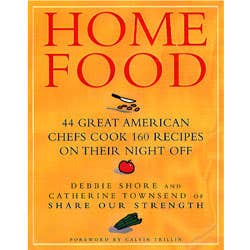
Home Fires
Some cookbooks are meant for the coffee table, others for the kitchen. Home Food: 44 Great American Chefs Cook 160 Recipes on Their Night Off (Clarkson Potter, 1995), by Debbie Shore and Catherine Townsend of Share Our Strength, though amply and attractively illustrated with photographs of chefs at home (often with their families), is of the kitchen variety. But it should be preserved, as well, for the next time capsule: It tells so much about the way we eat.
Historians will surely recall that, by the end of 20th century, we Americans were consuming half our meals away from home. But without a book like this as evidence, they might not understand how we personalized those meals. If Mom isn't making dinner in the home kitchen much today, we have turned the chefs who are feeding us in her place into substitute heroes and heroines—professional moms. This is a distinct departure from the way we used to view chefs.
The very origin of Home Food tells much about how the role of America's restaurant chefs has changed in recent years. It was conceived as a fund-raising project by Share Our Strength, the food industry hunger-relief organization. (Many of the chefs included here contribute to SOS's annual countrywide Taste of the Nation festivals. SOS also fights hunger through grant distribution and community outreach projects.) As Calvin Trillin notes in his foreword to this book, though today's American chefs seem to be having a good time in their work, "[n]o occupational group I know of has been more serious about its responsibilities to Americans who need help." The same chefs who feed the affluent in their restaurants, that is, also cook for fund-raisers, contribute leftovers to food-distribution programs for the poor and homeless, and teach food-service job skills to the disenfranchised. There were certainly exceptions, but the chefs in this country in decades past, in general, would hardly have been likely to show such selfless solidarity.
To see why the attitudes of (and our attitudes towards) the professionals who feed us are changing, compare the biographies of the European-trained chefs in this volume to those chefs who first started cooking in America: Italian-born Roberto Donna worked in a trattoria at age 9, went to cooking school at 13, and at 17 was the executive chef at Turin's best restaurant. French-born Michel Richard cooked for his family, apprenticed in various restaurants in his teens, and was top pastry chef at Lenotre in Paris by age 25.
In contrast, Rick Bayless had a graduate degree in linguistics before he went into professional cooking. Joyce Goldstein was a painter. Alfred Portale was a jewelry designer. It's no wonder that American chefs are more likely to wear baseball caps than toques in the kitchen these days.
Home Food wouldn't be nearly so appealing if its chefs weren't such objects of fascination. The recipes are at best secondary to the juicy bios of these culinary characters. This book devotes nearly as much space to the chefs' romances, children, and pets as it does to their recipes. Could anyone imagine Escoffier (or one of 19th-century China's master chefs) being depicted cuddling his dog or licking a whisk over a bowl of cake batter with his toddler? For that matter, could anyone imagine so many star chefs, in an earlier time, being women?
Perhaps not surprisingly, it is the women chefs who offer the simplest, time- and money-conscious dishes—for instance, Joyce Goldstein's Grilled Chicken Skewers in a Spiced Yogurt Marinade or Madeleine Kamman's Chicken Legs in Striped Pajamas (wrapped in pancetta or bacon and tossed with anise-scented carrots). What's more, their recipes are less often clogged with cream and butter.
The men's recipes tend to be heartier, and are more frequently company food. For dinner-in-a-hurry or on-the-cheap, the men's menus are best culled for their appetizers (John Ash's "Fire and Ice" Melon), side dishes (Stephan Pyles's Cowboy Beans), and desserts (Patrick Clark's Warm Bananas with Brandy Nutmeg Cream).
With a few notable exceptions, the recipes are fairly simple, though many do take for granted the ready availability of nasturtiums, arugula, holy basil, and the like. (While the committed cook can certainly find such ingredients in the larger American cities today, they're not likely to be available for an impromptu Sunday supper.) There are enough practical and delicious recipes here, though, to assure well-stained pages.
Even better than the recipes is the cooking lore. Every chapter is studded with short lessons and hints that go far beyond mere recipe instructions. There are tips on toasting seeds and on combining dried chiles. You can learn how to make a roux or flavored syrups. In case you haven't stayed current on such ingredients as Meyer lemons and quinoa, you can catch up in these pages.
As for the future, our children's children will undoubtedly be grateful that we preserved in print the moment that a chef—Elizabeth Terry—created the apogee of the pasta salad: fettuccine with peanut butter, soy sauce, mayonnaise, lemon juice, basil, and zucchini. If that's not pure fin-de-siecle 20th-century Americana, nothing is.
Keep Reading
Continue to Next Story










